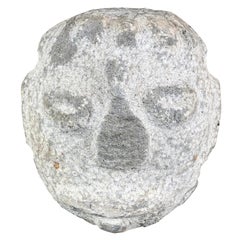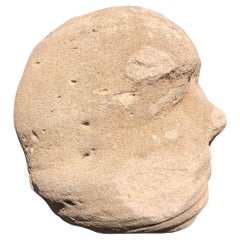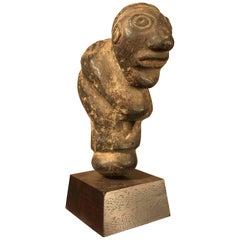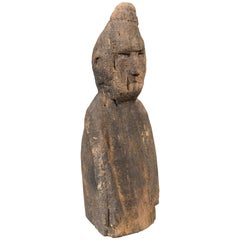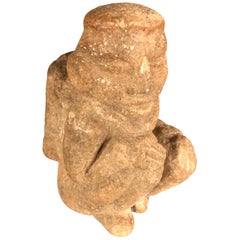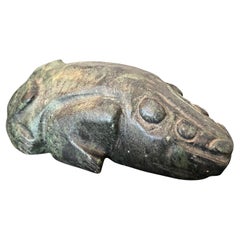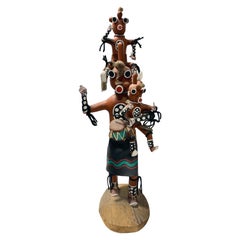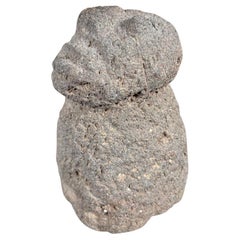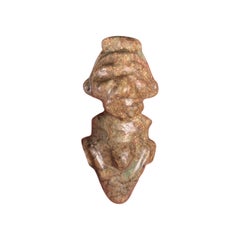Vermont - Native American Objects
to
2
638
20
10
6
2
2
8
3
1
1
1
10
10
10
10
10
Item Ships From: Vermont
Native America Antique Hand Carved Granite Human Head
Located in South Burlington, VT
From Native America comes this unique ancient hand carved granite stone head head effigy, attributed to the Yokuts People. It was collected on a private ra...
Category
19th Century American Antique Vermont - Native American Objects
Materials
Clay
Columbia River Massive Pre Contact Carved Stone Nine Effigies Ceremonial Mortar
Located in South Burlington, VT
From Native America's Northwest Columbia River area comes this substantial and unique ancient hand carved basalt stone ceremonial bowl or mortar possessing nine (9) human like heads within a circular double band, Columbia River.
It comes from a private Colorado collection.
The stone hand carved from a large basalt...
Category
15th Century and Earlier American Native American Antique Vermont - Native American Objects
Materials
Stone
Native America Old Natural Stone Human Head Effigy Sculpture
Located in South Burlington, VT
From Native America Southwest comes this unique natural stone "human head" effigy. It was discovered in the Tesuque area of New Mexico in 1960. It is a natural sandstone concretion...
Category
20th Century American Vermont - Native American Objects
Materials
Sandstone
Ancient American "Human Effigy" Stone Pipe, Woodland Period
Located in South Burlington, VT
Early American Pre-Historic Human Effigy stone pipe, woodland period, 2500 BP
Formerly in the Harold French collection, Amboy, Indiana (photo)
All st...
Category
15th Century and Earlier American Antique Vermont - Native American Objects
Materials
Stone
American "Human Effigy" Female Stone Sculpture, Tennessee, 1000 AD
Located in South Burlington, VT
A Native American Human Effigy female statue, Holliston Mills Site, Tennessee , sandstone, circa 1000 AD
Dimensions: 11.75 inches tall and 3.75 inches width 5.75 diameter
All stone carvings from America's Prehistoric past are scarce. The majority of known carved stones come from the far western Mimbres, Hohokam or Casas cultures.
This sculpture is unique.
Quality: fine original condition with varigated patina as found. Notice the detail of the carved ear spools...
Category
15th Century and Earlier American Antique Vermont - Native American Objects
Materials
Sandstone
Native America Ancient Hand Carved Stone Pipe Idol Sculpture
Located in South Burlington, VT
From Native America and a collection dating to 1951, comes this unique old hand carved stone human effigy pipe figure idol , likely Hopewell culture with its bun head and ear spool...
Category
15th Century and Earlier American Antique Vermont - Native American Objects
Materials
Stone
$3,600 Sale Price
47% Off
Native America Ancient Hand Carved Stone Kachina Effigy Sculpture
Located in South Burlington, VT
From Native America Southwest comes this unique ancient hand carved stone "Kachina" sculpture, Chaco culture, Farmington, New Mexico region. ...
Category
15th Century and Earlier American Antique Vermont - Native American Objects
Materials
Stone
$3,840 Sale Price
20% Off
Fine America’s Chieftain Ceremonial Figure
Located in South Burlington, VT
Pre-Columbian style , Hispaniola, Arawak Peoples, Taino Native Indians
This is a finely carved Taino Cacique Chief's hand carved hard wood figure- a superb ancestor style ceremonial...
Category
20th Century American Pre-Columbian Vermont - Native American Objects
Materials
Wood
Early American Plains Stone Buffalo Hunting Talisman
Located in South Burlington, VT
Native America Plains hand-carved and hand-painted stone Buffalo Hunting Talisman in the form of a buffalo hoof with human effigy head and tail , granite, 1800-1900
Dimensions: 12 inches high and 9.5 inches wide,
Provenance: old mid west collection
Hand-carved with great old paint and patina an authentic old work of art that is likely unique
Lifetime guarantee of authenticity: All of our works of art come with our lifetime authenticity guarantee.
Our gallery has been dealing in authentic Native...
Category
19th Century American Antique Vermont - Native American Objects
Materials
Granite
Ancient American "Human Effigy" Stone Paint Pallet, Anasazi Culture 900 AD
Located in South Burlington, VT
Early American Pre-Historic Human Effigy Stone Paint Pallet, Anasazi culture 900 AD
All stone carvings from America's Prehistoric southwest are scarce. The majority of known carved stones come from the
Mimbres, Hohokam or Casas cultures. So examples of stone carvings from the Anasazi culture
(circa 900–1300 AD) are rare especially human forms which are the rarest and some consider most desirable.
This pallet is likely unique.
The distinguishing characteristic of our paint pallet from the Anasazi culture is its creation from red sandstone- a material that was not used by
the Mimbres, Hohokam or Casas cultures.
Dimensions: 9.25 inches tall, 4.87 inches wide
Quality: it exhibits no less than seven distinct pigment colors on the surface. The obverse has a distinctive head with three dimensional eyes and nose; there are four horizontal bands of color: red, white, dark red/white and black. The center of the pallet has a distinctive white pigment and the border is executed in both red and black. There are two well-defined legs, one red and the other black, which terminate in distinctive feet. On the reverse we find in the center seven clearly defined concentric painted rings, each a different color.
Provenance: old New England collection
Lifetime guarantee of authenticity: All of our works of art come with our lifetime authenticity guarantee.
Our gallery has been dealing in authentic Native...
Category
15th Century and Earlier American Antique Vermont - Native American Objects
Materials
Sandstone
Related Items
Primitive Antique Native American Indigenous Stone Effigy Creature Sculpture
Located in Studio City, CA
An interesting and rather unusual indigenous native North or Central/South American (Mesoamerican) primitive stone carved (steatite or soapstone) mythical creature figure. We are no...
Category
Early 20th Century North American Folk Art Vermont - Native American Objects
Materials
Stone
$595
H 2 in W 5.25 in D 2.75 in
Large Signed Native American Hopi Original Mudhead Kachina Katsina Doll on Stand
By Native American Art
Located in Studio City, CA
A wonderfully handcrafted/detailed and decorated Native American Hopi Mudhead Kachina doll. Quite an unusually large work. A striking piece overall. Hand painted with leather and possibly turquoise (necklace) accompaniment.
Hopi katsina figures, also known as kachina dolls, are figures carved, typically from cottonwood root by the Hopi people. Initially, kachina dolls were made to instruct young girls and new brides about katsinas or katsinam, the immortal beings that bring rain, control other aspects of the natural world and society, and act as messengers between humans and the spirit world. The Mudhead or Koyemsi figure is viewed as a clown/joker figure who is responsible for laughter and entertainment at Hopi dances and ceremonial events. He plays drums and games to keep his audience engaged.
The piece is signed by the artist under the base.
From an extensive collection of Native American objects and artifacts. Would be a great addition to any Native American Art...
Category
20th Century American Native American Vermont - Native American Objects
Materials
Leather, Wood, Paint
$1,250
H 27 in W 10 in D 10 in
Southwestern Native American Signed Hopi Kachina Katsina Doll in Display Case
Located in Studio City, CA
Nicely made and displayed. Signed by the artist on the base.
Kachina figures are believed to act as messengers between humans and the spirit world.
Would be a great addition to any...
Category
20th Century American Native American Vermont - Native American Objects
Materials
Wood, Paint
$395
H 10 in W 5.5 in D 5.5 in
Grey Wolf Kachina Doll Hand Carved Signed by Artist
By Native American Art
Located in Studio City, CA
A wonderfully detailed and decorated wolf figure Kachina doll with fur.
Signed by the artist on the base.
From a collection of Native American objects an...
Category
20th Century American Native American Vermont - Native American Objects
Materials
Fur, Leather, Wood, Paint
Mid-Century Era Signed West Coast Cedar Haida Indigenous Canadian Totem Pole
Located in Hamilton, Ontario
This hand-carved cedar totem is signed by an unknown artist and presumed to have originated from Canada and dating to approximately 1960 and done in the West Coast Indigenous Haida s...
Category
Mid-20th Century Canadian Folk Art Vermont - Native American Objects
Materials
Cedar
$1,195
H 22.75 in W 10 in D 6 in
Native American Antique Large Micmac model Birch Bark canoe Woodlands C 1850
Located in London, GB
Native American Antique Large Micmac model Birch Bark canoe Woodlands C 1850
A superb Large Micmac Model Birch bark canoe with floral quill work decoration.
Native American Woodla...
Category
19th Century American Antique Vermont - Native American Objects
Materials
Birch
$1,828
H 6 in W 10 in D 35 in
Native American Southwest Pow Wow Drum
By Native American Art
Located in Coeur d'Alene, ID
Native American Southwest Pow Wow drum out of cottonwood log. Hide has a brand. Perfect for a coffee table with or without glass. Aged patina.
Period: Mi...
Category
Mid-20th Century American Native American Vermont - Native American Objects
Materials
Wood
Fine Long Vintage Native American graduated Navajo Silver bead Necklace 30 inch
Located in London, GB
Long graduated Navajo stamped silver bead Necklace 30 inch
circa 1960s.
.
Category
20th Century American Vermont - Native American Objects
Materials
Silver
$846
H 29.93 in W 1.19 in D 0.4 in
Quirky American Folk Art Human Form Chair
Located in Santa Monica, CA
Have a seat! One of a kind human form chair. Wonderfully carved muscles, toes, clenched fists for support. Looks like the chair is ready to go crawling ac...
Category
1940s American Folk Art Vintage Vermont - Native American Objects
Materials
Wood
Sioux Native Dragonfly Beaded Moccasins
Located in Coeur d'Alene, ID
Sioux moccasins with dragonflies. Fully beaded, including soles.
Fully beaded moccasins were made as special gifts for elders, respected individuals, or during rites of passages for ...
Category
1880s American Native American Antique Vermont - Native American Objects
Materials
Beads
Native American Papago Basket
By Native American Art
Located in Coeur d'Alene, ID
Papago basketry effigy bowl/jar with stylized quadrupeds and minor decoration around rim. Papago baskets are handcrafted of beargrass, yucca cactus (white or green) and Devil’s Claw ...
Category
Early 20th Century American Native American Vermont - Native American Objects
Materials
Natural Fiber
Primitive Antique Native American Mayan Mexican Folk Art Ocarina Fish Sculpture
Located in Studio City, CA
An interesting and rather unusual southwestern native North or Central American (Mesoamerican) primitive fish sculpture/instrument. We believe this piece is an earth-toned clay ocar...
Category
19th Century Mexican Folk Art Antique Vermont - Native American Objects
Materials
Clay, Earthenware, Pottery
$595
H 3.6 in W 7.5 in D 2.5 in
Previously Available Items
Ancient American Human Effigy Stone Star Gazer, Hohokam Culture
Located in South Burlington, VT
Early American Pre-Historic Human Effigy Stone Star Gazer, Hohokam culture
All stone carvings from America's Prehistoric southwest are scarce. The majo...
Category
15th Century and Earlier American Antique Vermont - Native American Objects
Materials
Stone
America’s Taino People Jade Pendant God
Located in South Burlington, VT
Hispaniola, Arawak peoples, Taino native Indians
This is a fine hand carved jade ancestor sculpture fashioned as a pendant from the Arawak Peoples of the Greater Antilles Islands, Dominican Republic. It is a good example and is accompanied by a certificate of authenticity as photographed.
Taino jades are extremely uncommon due to lack of local island jade cobble resources. Jade was likely traded into this country hundreds of years ago and this work of art is just one of a small collection found in a cave in La Altagracia Province, Dominican Republic in 1958.
Taino Jade Anthropic Pendant of a female figure, 20th century or earlier
Dimensions: 3.1 inches high, 8 cm
Sometimes described as a jade -cemi- this work of art belongs to a broader category of Taino art also called -zemis-. This term refers to the physical incarnation of a Taino god, spirit or ancestor. This figure may represent a Taino in trance and a similar might have adorned Cohoba ceremonies where hallucinogenic substances like cohoba were consumed to induce trances to communicate with the gods.
While the precise function of such objects remain somewhat a mystery- they continue to impress us with their bold abstract form and magical associations.
This remarkable sculpture figure is carved in a medium green jade with brown inclusions. This example has a large triangular carved head, slanted eyes, hands to its sides prominent nasal, open mouth, and pointed base.
As chieftains and important shamans were deified after death this sculpture may represent a cacique chief or high status member of Taino Community.
The arrangement of the figure’s limbs is an elaboration of the ritual squatting position that zemis assume in surviving stone amulets. In this case the legs are held up vertically with the feet resting under the waist. Both the face and in particular, the back of the body, are skeletal in appearance with prominent hollow joints. The wide eye-sockets and gaping jaw are deeply carved and both the forehead and the chin project outwards at a sharp angle. The emaciated look on the reverse, is carved in the half round. Both the ribs and the spine are indicated, set between elaborate geometric motifs which may indicate the presence of tattoos. The figure appears to rests on a simply carved pedestal.
To western sensibilities there is an obvious contradiction between the figure’s reverse skeletal form, suggestive of mortality.
Although Taino left no written documents, Spanish settlers did record native practices and one account refers to special structures in which chieftains stored their Trove of zemi carvings. The Taino believed in existence of afterlife and Shamanic ability to communicate with the dead. This sculpture may well have been present and on display in such a ceremony or perhaps a focus of ancestor worship.
Hand carved and scarce work of art from America's Caribbean islands.
Provenance: 1958 find, La Altagracia Provonce, Dominican Republic.
A "Certificate of Authenticity" accompanies
Taino History:
The Taino flourished from 1200-1500.
When Columbus arrived in America, the first people he encountered were the Taino People- inhabitants of the islands of the northern Caribbean Sea, known as Hispaniola. They were Arawakan-speaking people who at the time of Christopher Columbus’s exploration inhabited Cuba, Jamaica, Hispaniola (Haiti and the Dominican Republic), Puerto Rico, and the Virgin Islands. Once the most numerous indigenous people of the Caribbean, the Taino may have numbered several million at the time of the Spanish conquest in the late 15th century.
Their highly developed belief system focused on zemi ancestor or god worship. A zemi was the physical manifestation of a god, spirit or ancestor. The chieftain -caciques- encouraged ancestor worship and were often deified after death. The religious leaders or shamans were thought to be able to communicate with the souls of the dead when intoxicated by the hallucinogenic cohoba. A preoccupation with death is evident in many Taino art-forms and partly explains the prevalence of zoomorphic images. Bats, owls and frogs were all popular motifs and were regarded as harbingers of life after death. The Taino believed that the dead could be reborn in animal form and some believe animals were their earliest ancestors in Taino creation myth. Hence we find their zoomorphic sculptures as combinations of human and animal forms particularly provocative and great conversational art...
Category
20th Century American Pre-Columbian Vermont - Native American Objects
Materials
Jade
America’s First “Spirit God” Ancestor
Located in South Burlington, VT
Pre-Columbian, Hispaniola, Arawak Peoples, Taino Native Indians, early 20th century or older
This is an ancestor sculpture from the Arawak Peoples of the Greater Antilles Islands.
Sometimes described to a broader category of Taino art...
Category
Early 20th Century American Pre-Columbian Vermont - Native American Objects
Materials
Stone
Native America Ancient Hand Carved Stone Shaman's Mask "Tsagagial"
Located in South Burlington, VT
From Native America's Northwest coast comes this unique ancient hand carved granite stone head effigy, attributed to the Wasco culture, Columbia River, nea...
Category
15th Century and Earlier American Antique Vermont - Native American Objects
Materials
Stone
Native American Inuit Eskimo Antique Dance Mask, 1900
Located in South Burlington, VT
From our recent Acquisitions Across America - a fresh find from a California estate
This finely hand carved and hand painted Alaskan Inuit antique wooden dance mask is a superb example of Eskimo culture. It's character and creation was inspired by native cultural vision and tradition. It is a Fine 120 year old hand carved example that would be a provocative accent to the most discerning collection.
Measurements: Large 17.5 inches long and 13 inches at widest
The Purpose of Inuit Masks...
Category
Early 20th Century Canadian Native American Vermont - Native American Objects
Materials
Wood
America’s Treasure Jade Find Hallucinogenic Pendant God, 500 Years Old #1
Located in South Burlington, VT
Pre-Columbian, Hispaniola, Arawak peoples, Taino native Indians, 1000-1500 CE.
This is a fine and important hand carved jade ancestor sculpture fashioned as a pendant from the Arawak Peoples of the Greater Antilles Islands, Dominican Republic. It is a rare, choice example and is accompanied by a certificate of authenticity as photographed.
Taino jades are extremely uncommon due to lack of local island jade cobble resources. Jade was likely traded into this country hundreds of years ago and this work of art is just one of a small collection found in a cave in LaAltagracia Provonce, Dominican Republic in 1958.
Taino Jade Anthropic Pendant of a female figure, 1000-1500 AD
"Certificate of Authenticity".
Dimensions: 3.1 inches high, 8 cm
Sometimes described as a jade -cemi- this work of art belongs to a broader category of Taino art...
Category
15th Century and Earlier American Pre-Columbian Antique Vermont - Native American Objects
Materials
Jade
America Ancient Stone Game Ball "Batey", 500 Years Old
Located in South Burlington, VT
Pre-Columbian, Hispaniola, Arawak Peoples, Taino Native Indians, 1000-1500 CE.
This is a fine and important hand carved/pecked stone game ball (batey) from the Arawak Peoples of the Greater Antilles Islands. It is a choice and large example. It is finely incised on all planes with multiple stylized geometric motifs representing tattooing or scarification and faces, adding to the impressive aesthetic presence of this piece.
Batey (game) Batéy was the name given to a special plaza around which the Caribbean Taino built their settlements. It was usually a rectangular area surrounded by stones with carved symbols. The batey was the area in which batey events (e.g. ceremonies, the ball game, etc.) took place.
This form might have served as a marker or trophy symbol in a Taino inter- village ball game and ceremony. The exact purpose of ball games remain a mystery but they may have served to settle political disputes.
While the precise function of such objects remain somewhat a mystery- they continue to impress us with their bold abstract form and magical associations.
This remarkable sculpture is carved in a light colored iron rich hard stone like limestone. On the surfaces are finely incised stylized geometric motifs representing tattooing or scarification, adding to the impressive aesthetic presence of this piece.
A carving of this complexity, quality and size must have belonged to a chieftain or ranking member of the royal household. Although Taino left no written documents, Spanish settlers did record native practices and one account refers to special structures in which chieftains stored their Trove of zemi and other important carvings. The Taino believed in existence of afterlife and Shamanic ability to communicate with the dead. This sculpture may well have been present and on display in such a ceremony or perhaps a focus of ancestor worship. This remarkably evocative work allows us to peak into ancient splendors of their remarkable civilization.
Dimensions: 8.5 inches diameter
Hand-carved/pecked. Venerated. An important and scarce work of art from America's Caribbean islands.
Provenance: Old Puerto Rico collection collected 1950s-1960s, Frank Vasquez
Taino History:
The Taino flourished from 1200-1500.
When Columbus arrived in America, the first people he encountered were the Taino People- inhabitants of the islands of the northern Caribbean Sea, known as Hispaniola. They were Arawakan-speaking people who at the time of Christopher Columbus’s exploration inhabited Cuba, Jamaica, Hispaniola (Haiti and the Dominican Republic), Puerto Rico, and the Virgin Islands. Once the most numerous indigenous people of the Caribbean, the Taino may have numbered several million at the time of the Spanish conquest in the late 15th century.
Their highly developed belief system focused on zemi ancestor or god worship. A zemi was the physical manifestation of a god, spirit or ancestor. The chieftain -caciques- encouraged ancestor worship and were often deified after death. The religious leaders or shamans were thought to be able to communicate with the souls of the dead when intoxicated by the hallucinogenic cohoba. A preoccupation with death is evident in many Taino art-forms and partly explains the prevalence of zoomorphic images. Bats, owls and frogs were all popular motifs and were regarded as harbingers of life after death. The Taino believed that the dead could be reborn in animal form and some believe animals were their earliest ancestors in Taino creation myth. Hence we find their zoomorphic sculptures as combinations of human and animal forms particularly provocative and great conversational art...
Category
15th Century and Earlier American Pre-Columbian Antique Vermont - Native American Objects
Materials
Stone
America’s Ancestor Hallucinogenic God, 500 Years Old
Located in South Burlington, VT
Pre-Columbian, Hispaniola, Arawak Peoples, Taino Native Indians, 1000 to 1500 CE.
This is a fine and important hand carved/pecked ancestor sculpture from the Arawak Peoples of the Greater Antilles Islands. It is a choice example.
Sometimes described as a -cemi- this work of art belongs to a broader category of Taino art...
Category
15th Century and Earlier American Pre-Columbian Antique Vermont - Native American Objects
Materials
Stone
Fine America’s Chieftain Ceremonial Wood Seat “Duho”
Located in South Burlington, VT
Pre-Columbian style , Hispaniola, Arawak Peoples, Taino Native Indians
This is a finely carved Taino Cacique Chief's hand carved hard wood seat -Duho- a superb ancestor style ceremonial sculpture from the Arawak Peoples of the Greater Antilles Islands. It comes from a Florida collection.
This Duho or seat made from a single piece of wood, representing an anthropomorphic figure with sculptured head and finely engraved with a large Cacique face and linear motifs on the main flat top, and in ancient times similar would have been used by the principal practitioner of the cohoba ritual. In ancient times, Duhos were used by the Cacique while observing the ball games commonly played by the Taino's. circa 1200-1550 A.D.
While the precise ancient function of such objects remains somewhat a mystery- they continue to impress us with their bold abstract form and magical associations.
In the seminal book Taino, Pre-Columbian Art & Culture from the Caribbean published by the El Museo del Barrio, ancient duho are discussed at length as private power-objects used in egalitarian tribes and used in public ritual to legitimize the hierarchical social structure of complex chiefdoms. Please also refer to the excellent publication March 1994 seminal article Tribal Arts: The Sculptural Ancestry of the Taino- masterpieces from the Pre-Columbian West Indies. (photos).
This remarkable sculpture includes a Zemi figure face which was meticulously incised with round deep-socketed eyes, prominent nasal cavities, drilled ear lobes possibly for feather fetishes...
Category
20th Century American Pre-Columbian Vermont - Native American Objects
Materials
Wood
America’s First Columbus Ancestor 500 Years Old
Located in South Burlington, VT
Pre-Columbian, Hispaniola, Arawak Peoples, Taino Native Indians, 1000 to 1500 CE.
This is a fine and important ancestor sculpture from the Arawak Peoples of the Greater Antilles Islands. It is a choice example.
Sometimes described as a -cemi- this work of art belongs to a broader category of Taino art...
Category
15th Century and Earlier American Pre-Columbian Antique Vermont - Native American Objects
Materials
Stone
America’s First “Spirit God” Double Headed Ancestor 500 Years Old
Located in South Burlington, VT
Pre-Columbian, Hispaniola, Arawak Peoples, Taino Native Indians, 1000-1500 CE.
This is a fine and important ancestor sculpture from the Arawak Peoples of the Greater Antilles Islands. It is as nice as one will ever find.
Sometimes described as a -three-pointer stone or - trigonolitos- this work of art belongs to a broader category of Taino art...
Category
15th Century and Earlier American Pre-Columbian Antique Vermont - Native American Objects
Materials
Stone
Native America Antique Seated Human Effigy "Star Gazer"
Located in South Burlington, VT
Native America seated human effigy "Star Gazer", 14cm, 5.6” high, 19th century or earlier.
The seated earth mother posed figure fashioned from a dense ...
Category
19th Century American Antique Vermont - Native American Objects
Materials
Clay
Recently Viewed
View AllMore Ways To Browse
Crow Beaded
Sioux Beadwork
Antique Native American Drum
Antique Native American Rings
Beaded Leggings
Native American Knife
Native American Pacific Northwest Carved
Native American Painted Hides
Nuu Chah Nulth
Sioux Beaded Moccasins
Alaska Totem Pole
Alaska Totem
Native American Parfleche
Native American Raven
Pueblo Drum
Acoma Pueblo Pottery
Haida Totem
Lakota Sioux
